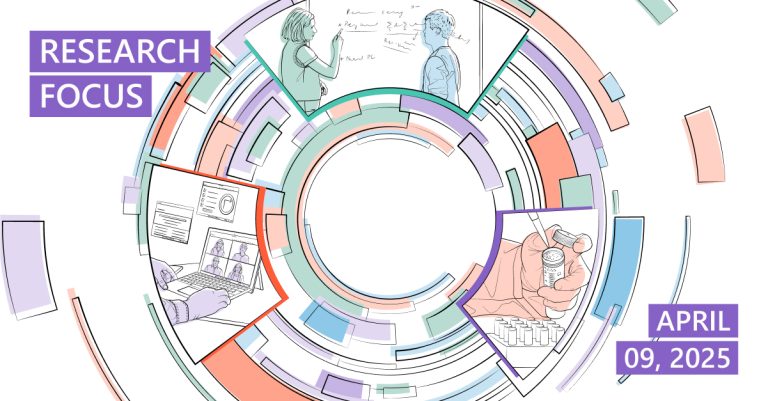In this issue:
We introduce a new dataset designed to assist renewable energy infrastructure planners, a new method for denoising MRI imagery, and an AI tool for analyzing distant galaxies. Check out our latest research and other updates.

NEW RESEARCH
Global Renewables Watch: A Temporal Dataset of Solar and Wind Energy Derived from Satellite Imagery

Siting renewable energy infrastructure requires careful consideration of the potential impact on ecosystems, cultural and historical resources, agriculture, and scenic landscapes. To help policymakers, researchers, and other stakeholders assess strategies for deployment, researchers from Microsoft, The Nature Conservancy (opens in new tab), and Planet (opens in new tab) present a comprehensive global temporal dataset of commercial solar photovoltaic (PV) farms and onshore wind turbines.
The researchers built the dataset by training deep learning-based segmentation models on high-resolution satellite imagery and then deploying them on over 13 trillion pixels of images covering the world. The final spatial dataset includes 375,197 individual wind turbines and 86,410 solar photovoltaic installations. For each detected feature, they estimate the construction date and the preceding land use type, and aggregate their findings to the country level, along with estimates of total power capacity.
NEW RESEARCH
SNRAware: Improved Deep Learning MRI Denoising with SNR Unit Training and G-factor Map Augmentation
This research proposes a new training method, SNRAware, to improve the ability of deep learning models to denoise—or remove unwanted random variations—from MRI images. MRI images can suffer from high levels of noise when scanning is accelerated with parallel imaging or when data are acquired using lower cost, low-field MRI systems.
The researchers tested SNRAware on 14 different models, including ones based on transformer and convolutional architectures. The proposed training scheme improved the performance of all the tested models. This broad applicability means that the method is flexible and can be applied to different kinds of models without redesigning them. The testing showed SNRAware significantly improves the quality and clinical utility of MRI images while preserving important diagnostic details.

NEW RESEARCH
Can AI unlock the mysteries of the universe?

Analyzing the physical properties of individual galaxies is a fundamental skill in astronomy. It requires a thorough understanding of galaxy formation theories and the ability to interpret vast amounts of observational data. However, even for seasoned astronomers, this process can be time-consuming and labor-intensive. To help astronomers accelerate this fundamental process, researchers from Microsoft and external colleagues introduce Mephisto, research designed to analyze extremely distant galaxies observed by the James Webb Space Telescope (JWST).
Mephisto analyzes photometric data from distant galaxies, proposing physical models and interacting with Code Investigating Galaxy Emission (opens in new tab), a commonly used galaxy spectral simulation program. Mephisto can detect discrepancies between models and observational data, identifies potential instrumental errors or limitations in the models, iteratively adjusts parameters, and generates multiple explanations for the observational data.
APPLIED AI
Japan Airlines’ new AI app will make it easier for cabin attendants to report inflight events with Microsoft’s Phi-4 small language model
Japan Airlines (JAL) is using technology developed by Microsoft Research to deploy an AI app that helps flight crews communicate more effectively with ground staff when something unexpected comes up during a flight.
The JAL-AI Report is being developed using Microsoft’s Phi-4 small language model (SLM), which requires less computing power than the large language models (LLMs) most generative AI tools run on, so it can be used offline on a device for specific tasks.
Cabin attendants who have tried it say it can slash the time for writing operation reports by up to two thirds, say, from one hour to 20 minutes, or from 30 minutes to 10 for simpler cases.
Microsoft Research | In case you missed it
AI weather forecast project eyes access through desktop computers
Financial Times | March 20, 2025
Aardvark Weather uses AI to deliver accurate forecasts in just minutes from a desktop computer. Developed by scientists at the University of Cambridge, with support from the Alan Turing Institute, Microsoft Research, and the European Centre for Medium-Range Weather Forecasts, this technology is tens of times faster than existing methods and requires only a fraction of the computing power.
Director of Microsoft Research talks AI for science (what it really means)
The Deep View | March 11, 2025
Chris Bishop, Director, AI for Science, Microsoft Research, discusses what AI is doing for science. This interview dives into how AI is accelerating discovery of new techniques and findings, the benefits of foundation models like Aurora, MatterGen’s capabilities, and AI’s impact on scientists.
Microsoft’s Christopher Bishop: Scientific discovery is AI’s killer application
Financial Times | April 3, 2025
Christopher Bishop runs Microsoft’s AI for Science research unit, which applies the powerful technology to the natural sciences. Bishop sees the mission of the lab, which was founded in 2022, as accelerating scientific discovery using the technology.
In this conversation with the Financial Times’ AI editor Madhumita Murgia, he explains why he believes scientific discovery will prove to be the single most important application of the technology.
Innovation to Impact (ft. Dr M – DGTL Voices with Ed Marx)
DGTL Voices with Ed Marx | March 12, 2025
Matthew Lungren, Chief Scientific Officer, Microsoft Health and Life Sciences, and Jonathan Carlson, Managing Director, Microsoft Health Futures, discuss AI’s transformative impact on radiology and the importance of collaboration in research and product development. They highlight how healthcare organizations can leverage Microsoft’s resources for innovation, emphasizing Microsoft’s progress in developing radiology-specific multimodal models and its broader work in healthcare.
Microsoft Unveils New AI Model to Edit Video Games
IEEE Spectrum | March 11, 2025
Lead researcher Katja Hoffman discusses Microsoft’s Muse, a transformer model with 1.6 billion parameters trained on 500,000 hours of player data that can generate gameplay examples from a single screenshot.
National University of Singapore collaborates with Microsoft Research Asia to advance AI research and cultivate computing talent
NUS News | April 2, 2025
The National University of Singapore (NUS) has signed a five-year collaboration agreement with Microsoft Research Asia for a Joint PhD Supervision Program, bringing together NUS’s academic and research excellence with Microsoft Research Asia’s global leadership in AI, computing research, and industrial applications to cultivate talent. As part of this collaboration, NUS and Microsoft Research Asia will nurture PhD students through the Industrial Postgraduate Program, supported by the Singapore Economic Development Board (EDB). This initiative will help to cultivate interdisciplinary, high-caliber tech professionals and drive the integration of AI technology across industries.
How Microsoft made it through 50 years
The Verge | April 4, 2025
A lot has changed since Microsoft was founded, but in many ways, the company’s core business model and ethos remain the same: make software that everyone needs and get it installed everywhere. Adapting to change, including the ongoing AI transformation, has always played an important role in the company’s success.



